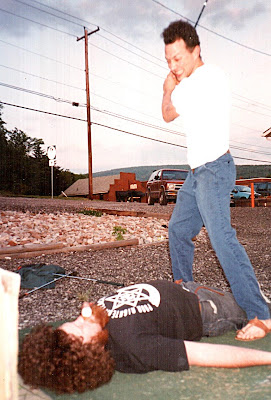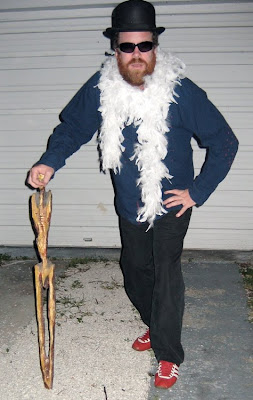
from the archives...
Originally the diary of 4 months spent in Antarctica working as a documentary film sound recordist, this blog has evolved into an online repository for the thoughts, travels and trivia of the writer Richard Fleming. For McMurdo Station, Antarctica, and polar exploration, see August through December of '06. Currently you are likely to find in these pages chronicles of my actual and literary meanderings, as well as notes on my many other passions. Also, did I mention I wrote a book?
 Only, gulp, 1100+ kilometers to go!
Only, gulp, 1100+ kilometers to go! Graffiti left by pilgrims who passed this way earlier...
Graffiti left by pilgrims who passed this way earlier...
 Mom hits the road
Mom hits the road We were amazed once again by the focused simplicity of life on pilgrimage, and fell happily into the repeater pattern of walking (vigorously), sleeping (soundly), eating (heartily)—and laundry (vital). We marveled at the varieties of architecture, of fauna and flora, of people whom we met or who hosted us, and the places we stayed: There was the couple who miraculously survived the tsunami while vacationing in Sri Lanka and had committed to walking from their home in Austria to Compostela as an act of gratitude, because “we needed to do something ‘impossible’;” and the calm symmetry of the 12th-century cloister at Moissac, where a remarkable tympanum depicts the beatific vision, while below, a line of patriarchs and kings gape upwards in stupefaction … We came upon, surely, the world’s longest earthworm, over two and a half feet long; and then there were the huge and mystifying wooden ladders propped up in the forest—whatever for?
We were amazed once again by the focused simplicity of life on pilgrimage, and fell happily into the repeater pattern of walking (vigorously), sleeping (soundly), eating (heartily)—and laundry (vital). We marveled at the varieties of architecture, of fauna and flora, of people whom we met or who hosted us, and the places we stayed: There was the couple who miraculously survived the tsunami while vacationing in Sri Lanka and had committed to walking from their home in Austria to Compostela as an act of gratitude, because “we needed to do something ‘impossible’;” and the calm symmetry of the 12th-century cloister at Moissac, where a remarkable tympanum depicts the beatific vision, while below, a line of patriarchs and kings gape upwards in stupefaction … We came upon, surely, the world’s longest earthworm, over two and a half feet long; and then there were the huge and mystifying wooden ladders propped up in the forest—whatever for? Harvesting walnuts, maybe?
Harvesting walnuts, maybe? "Drenched but triumphant"
"Drenched but triumphant"
 "Gede is always dressed in black, usually with a tail coat and top hat. (He) has special prerogatives. He does not fear criticism. He flouts propriety at will, he embarrasses, provokes, and insults with impunity." Harold Courlander
"Gede is always dressed in black, usually with a tail coat and top hat. (He) has special prerogatives. He does not fear criticism. He flouts propriety at will, he embarrasses, provokes, and insults with impunity." Harold Courlander Tuning up the drums at Tap-Tap; once the retaining ring holding the goatskin against the top of the drum has been hammered down tight, the hemp cords are knotted and cinched to preserve the proper tone.
Tuning up the drums at Tap-Tap; once the retaining ring holding the goatskin against the top of the drum has been hammered down tight, the hemp cords are knotted and cinched to preserve the proper tone. At about ten o'clock, with quite a number of apparently bemused tourist diners still dotted about the room enjoying their Caribbean desserts , the thunderous drumming began, along with invocations to Legba, the guardian of the crossroads and the gateway to the spirit world. He is the first spirit to be greeted in any ceremony. As Maya Deren puts it, Legba must be consulted to reach divine counsel, in the same way that Gede must be consulted to reach ancestral counsel.
At about ten o'clock, with quite a number of apparently bemused tourist diners still dotted about the room enjoying their Caribbean desserts , the thunderous drumming began, along with invocations to Legba, the guardian of the crossroads and the gateway to the spirit world. He is the first spirit to be greeted in any ceremony. As Maya Deren puts it, Legba must be consulted to reach divine counsel, in the same way that Gede must be consulted to reach ancestral counsel. Barbancourt Rum bottle in use as percussion instrument
Barbancourt Rum bottle in use as percussion instrument It's getting sweaty in here!
It's getting sweaty in here! Gede's colors are purple, black and white. Baron Samedi is the leader of the tribe of the Gedes, of which there are many, both recognizable and too obscure to be named. It is impossible to identify them all, and in fact, the way it has been explained to me in Haiti, the extended family of gedes appears to be a sort of sub-pantheon of spirits that includes all deceased ancestors.
Gede's colors are purple, black and white. Baron Samedi is the leader of the tribe of the Gedes, of which there are many, both recognizable and too obscure to be named. It is impossible to identify them all, and in fact, the way it has been explained to me in Haiti, the extended family of gedes appears to be a sort of sub-pantheon of spirits that includes all deceased ancestors.  The drumming was intense, physical work, but there always seemed to be a reservoir of fresh drummers in the crowd, ready to sit in and take a turn.
The drumming was intense, physical work, but there always seemed to be a reservoir of fresh drummers in the crowd, ready to sit in and take a turn. Let the merciless humping begin...
Let the merciless humping begin... Wave your stick in the air with festive abandon!
Wave your stick in the air with festive abandon! I was staying in Miami with my friend Jody, who has never thrown away a single Halloween costume. She lent me this fertility cane, bowler hat, sunglasses and ostrich feather boa for the evening. The anthropologist Alfred Metraux writes of the Gede that "from some angles they look terrifying, from others merely ridiculous," but I'm fearful that I only achieved the latter. The bowler doesn't have quite the Freudian oomph of Baron Samedi's traditional stovepipe top hat, and I'm afraid I ended up looking more like a fey Charlie Chaplin than a corpse-like guardian of the cemetery.
I was staying in Miami with my friend Jody, who has never thrown away a single Halloween costume. She lent me this fertility cane, bowler hat, sunglasses and ostrich feather boa for the evening. The anthropologist Alfred Metraux writes of the Gede that "from some angles they look terrifying, from others merely ridiculous," but I'm fearful that I only achieved the latter. The bowler doesn't have quite the Freudian oomph of Baron Samedi's traditional stovepipe top hat, and I'm afraid I ended up looking more like a fey Charlie Chaplin than a corpse-like guardian of the cemetery.

 Our happy film crew only a few hours before our first shower in 51 days: Anne Aghion, moi, and Sylvestre Guidi
Our happy film crew only a few hours before our first shower in 51 days: Anne Aghion, moi, and Sylvestre Guidi


